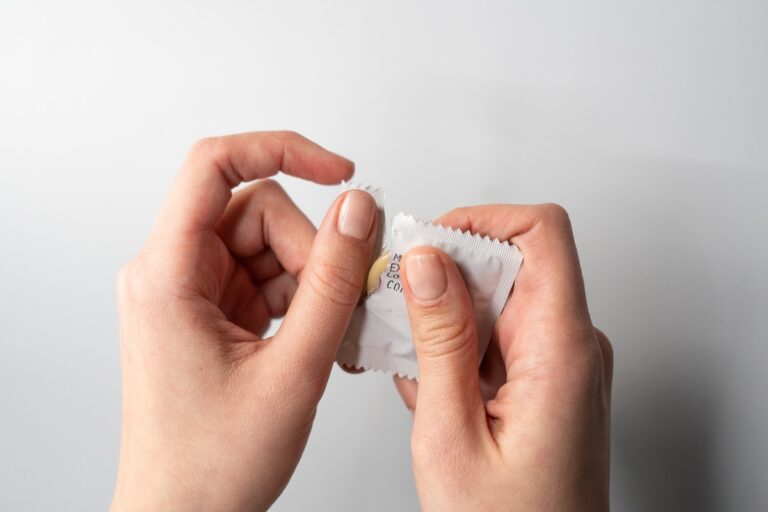A female condom, also known as the FC2 and a woman’s condom, is a sheath inserted into the vagina or anus during sex to prevent pregnancy and sexually transmitted diseases. It works by creating a barrier to prevent the passage of sperm to an egg.
It is available by prescription only through a health care provider and is one of the 18 methods covered by the Affordable Care Act’s birth control mandate. It costs $2-4 a condom and can be purchased online or at Planned Parenthood health centers and family planning and health clinics.
External Condoms
Condoms are a barrier method of birth control that prevent pregnancy by stopping sperm from meeting an egg and can protect against sexually transmitted diseases (STIs). They’re available in a wide variety of styles, shapes, and colors. They’re inexpensive and easy to find at drug stores, convenience stores, and some clinics and clubs.
Female condoms, also called universal or insertive condoms, are thin protective sheaths with flexible rings at each end and a foam disc inside. The ring at the closed end is inserted into the vagina during sexual intercourse, while the other end stays outside the body. These sheaths are made of nitrile, polyurethane, or latex and can be used with lubricant.
The ring at the open end of the sheath can fit a range of penis sizes, and it’s rolled to allow for insertion without tearing. They can be inserted up to eight hours before sexual intercourse, and they offer protection against unintended pregnancy as well as STIs.
They’re also allergy-friendly, as they don’t contain latex or natural rubber. They’re made with a soft, lubricated material that can be worn by people with latex allergies. They’re also safe to use with both water-based and oil-based lubricants. They don’t interfere with the urinary tract, so urination is still possible while wearing them. You can buy internal condoms online or at drug stores, convenience and grocery stores, and adult shops. They’re also available for free at some health centers, family planning clinics, and youth clinics.
Internal Condoms
A female condom, also known as an internal condom, is a thin nitrile pouch that a person puts inside the vagina before sexual activity. It has two flexible rings at each end – the inner and outer ring. The inner ring is closed and rests inside the vagina, while the outer ring sits outside and is pushed flat against the labia (the folds of skin on the sides of the vagina also known as “lips”).
You can buy female condoms at some general practitioners (GPs) or sexual health clinics and online. In the UK, they’re also available for free from some pharmacies and supermarkets. These condoms are suitable for use by both women and men. People can insert them up to 8 hours before sex, or as soon as they start having sex. It is important to remember that the condom is only effective if it is inserted correctly. It may not be as effective at preventing pregnancy and STIs as an external condom, but it’s still safer than no protection at all.
The only FDA-approved internal condom is called the FC2. It costs about $3.50 per condom, but is cheaper if you get a prescription from your doctor. You can get it at most pharmacies, and some health centers and family planning clinics also offer it for free or at a low cost. Most insurance plans cover all FDA-approved methods of birth control, including internal condoms.
Cost
Unlike male condoms, which can be purchased at most drugstores and STI clinics without a prescription, female condoms require one. They cost a little more than male condoms ($2 per female condom compared to $0.50 to $1 for boxes of several condoms). However, the Chicago Female Condom Campaign, a coalition of HIV/AIDS and women’s health organizations, has raised funds to ensure that female condoms are affordable and available.
The reusable, non-latex FC2 condom has soft rings on each end and a pouch in the middle. One ring rests outside the vulva while the other fits inside and can be held in place with a lubricant or the sheath. It’s a great option for people with latex allergies. And while it won’t eliminate your risk of STDs, it can cut them significantly.
It can also be washed, disinfected, and reused. A study comparing a polyurethane version to the current nitrile version found that the newer product “did not demonstrate increased sensitivity, penile discharge, or symptomatic vaginal irritation when subjected to seven cycles of washing, drying and relubrication.”
The company that makes the FC2 has recently redesigned its package to remove some of the clinical feel of the old model and make it more visually appealing. This could help boost sales, especially since many insurers will cover internal condoms if a medical provider prescribes them.
Where to Buy
A box of 12 internal condoms costs between $2-$3. They are available in some drugstores and online. You can also get them from family planning clinics and sexual health centers. These places usually offer them for free. If you are unsure of the best place to buy them you can ask a doctor or nurse. They can advise you on the best option based on your health and lifestyle. They may also recommend using lubricant while inserting them to reduce irritation or discomfort.
If you have insurance, the internal condom might be covered. Veru Health is making it easier for people with insurance to purchase FC2 by moving from the traditional pharmacy model to a prescription distribution. The company hopes this will help get doctors involved in the promotion of the product and will increase access to the contraceptive method. Advocates say that the move is likely to increase the cost of the internal condom and could leave uninsured women without access.
It is important to remember that the internal condom can go out of date so make sure you check the expiration date before using it. It is also a good idea to use male condoms at the same time as this increases the protection against pregnancy and STDs. You can also use other forms of birth control to add extra protection such as hormonal birth control or an IUD.
See Also:



